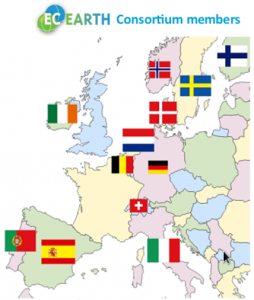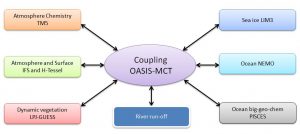Met Éireann conducts climate research, both at a regional and global scale, in support of the Irish National Climate Change Adaptation Framework and the Intergovernmental Panel on Climate Change (IPCC).
Coupled Model Intercomparison Project (CMIP)
The CMIP is organised under the World Climate Research Program and was set up to better understand past and future climate change. Since it started, it has formed an important part of the Intergovernmental Panel on Climate Change (IPCC) Assessment Reports. Met Éireann has carried out runs for the 5th CMIP phase (CMIP5) with the EC-Earth climate model and will do so for the upcoming CMIP6.
EC-Earth
The EC-Earth European consortium was set up to develop a new improved fully coupled atmosphere-ocean-land-biosphere global climate model. Met Éireann and the Irish Centre for High End Computing (ICHEC) form the EC-Earth consortium for Ireland.

EC-Earth Consortium members
The EC-Earth climate model has an atmospheric component (ECMWF IFS model, cycle 36r4), ocean component (NEMO global ocean circulation model) and sea-ice component (LIM sea ice model, University of Louvaine-la-Neuve), and others. EC-Earth is under continuous development; the latest version (3.2) will be used for the CMIP6 (Figure 2). The latest version includes a vegetation and ocean biogeochemistry model, and an updated compiler.

EC-Earth Climate Model
Met Éireann carried out a series of CMIP5 ensemble runs to 2100, under medium to high radiative RCP forcings. Change in climate is measured by looking at the change in a certain parameter between a certain future period and baseline period. The change in annual 2m temperature with respect to the 1961-1990 baseline, for high and low RCP scenarios (4.5 and 8.5), is shown in the following animation:
Preparation for CMIP6 is in progress and it is intended that the CMIP6 runs will start later in 2017.
The Atlantic Meridional Overturning Circulation (AMOC) is a key are of focus for our Climate Modelling unit. For more information, check out our dedicated AMOC webpage.